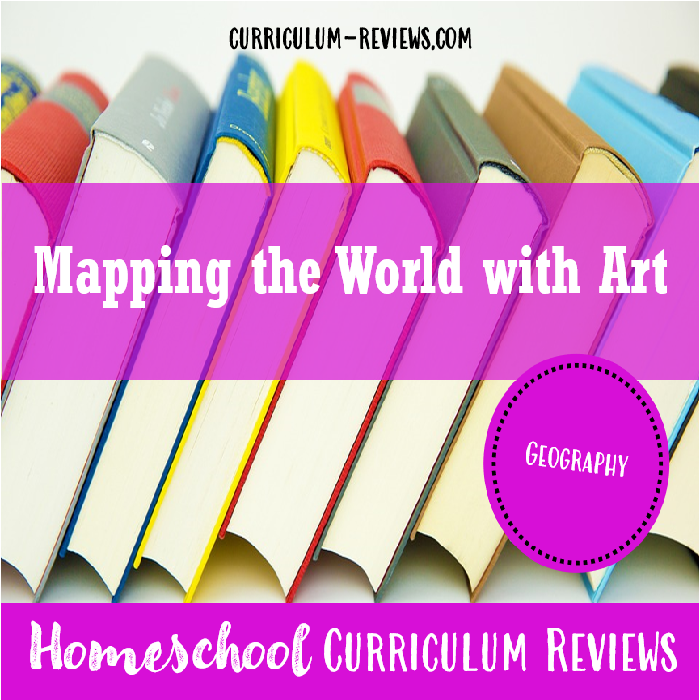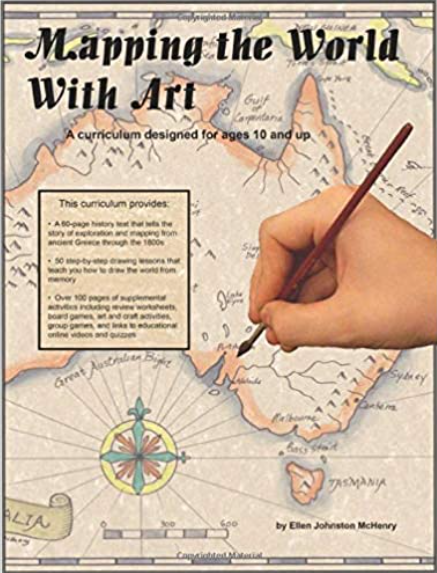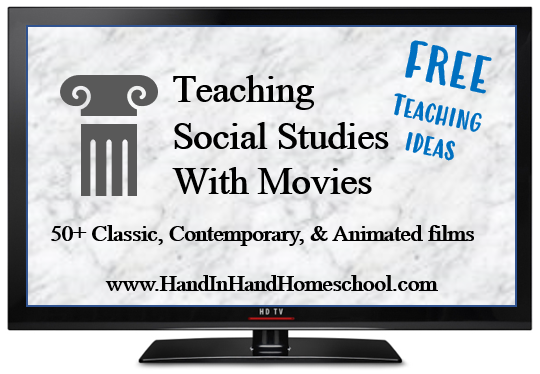
Mapping the World With Art
Mapping the World With Art (which was written as an alternative curriculum to Mapping the World By Heart) is one of the most popular homeschool geography curriculums on the market. The concept is simple and easy to implement: Read a 2-page mini-history lesson on mapmaking and then draw a map about the historical and geographical region. For the less artistic, you can watch 6 hours of instructional DVDs to help with the drawing and painting portions of the lesson.
As you work your way through 30 history and art lessons, you get a sense of time and place in the world. With 100 pages of supplemental activities, you can easily expand your lessons with videos, hands-on projects, and even worksheets so you can create a truly meaningful middle school social studies credit. The curriculum culminates by having kids create a complete map of the world in any art medium they choose.
No doubt exists that you’ll gain invaluable art experience from this curriculum. The step-by-step directions, along with ample pictures detailing how to draw each map, are exceptionally executed. Blending art with map-making offers a refreshing new take on a subject that doesn’t always get its fair share of attention.
Mapping the World With Art is not a complete history curriculum. Kids are introduced to an assortment of historical figures, like Portugal’s Henry the Navigator, Morocco’s Ibn Battuta, and China’s Zeng He before they tackle a new map drawing activity. The mini history lessons provide way more information in each 2-page spread than you might expect. They offer a great launching point to dig a little deeper, if you wish to expand the history learning aspect of this curriculum.
At the same time, history-loving readers will most likely take note of some of the generalized (and questionable) statements sprinkled throughout the book. For example, in the Marco-Polo lesson, McHenry states, “… Kublai Khan (the grandson of the infamous Genghis Kan), had requested that missionaries come to his kingdom to teach his people about Christianity.” Yet, McHenry does not offer any substantial commentary to help readers learn about the centuries of doubt that revolve around Marco Polo’s journey to China. More scholarly history lovers may even cringe at such esoteric mistakes, as referring to “Germanic tribes” as “Germans”, which is a geo-political term that describes a different time period and people.
Another concern for some families may be the curriculum’s hyper-focus on Western Civilization, despite being a world geography class. While McHenry touches on each of the 7 continents, it’s disappointing to see that Africa only warrants one lesson (well, technically 2, if you count the lesson on the Nile River). As the birthplace for all of mankind; the home to many varied and rich cultures; and a land with deep connections to America – it’s disappointing to see such a cursory nod being given.
While the curriculum is essentially secular, you will find a smattering of Christian references, such as a passing mention of the Shroud of Turin. Families should also note that in addition to purchasing the book, they will also need to buy a variety of art materials. In addition to the print book, families can also choose a digital download version, as well as an e-course.
Chapter Summary:
1- Mesopotamia
2- Nile River
3- Greece
4- Roman “Boot”
5- Holy Land & Arabian Peninsula
6- Black, Caspian, & Aral Seas
7- Iberian Peninsula
8- France
9- Indian “Subcontinent”
10- Greater Antilles
11- Lesser Antilles
12- Britain & Newfoundland
13- Africa
14- Central America & Caribbean
15- South America
16- Malay Peninsula & Southern Asia
17- Pacific Islands
18- Strait of Magellan & Phillipines
19- North America, East coast
20- Gulf of St. Lawrence
21- North America, West coast
22- Scandinavia
23- Low Countries, Ireland, & Iceland
24- Northern Canada
25- Japan
26- Australia & New Zealand
27- Alaska
28- Rest of North America & Asia
29- Other Pacific Islands
30- Antarctica
 About the Author: Ellen J McHenry is a homeschool mother who holds an art degree, with a minor in math, from Penn State. She has worked as a professional illustrator for more than 20 years. During her years teaching homeschool co-op science classes, Ellen recognized a need for a different type of instructional material and so her career as a curriculum writer was born.
About the Author: Ellen J McHenry is a homeschool mother who holds an art degree, with a minor in math, from Penn State. She has worked as a professional illustrator for more than 20 years. During her years teaching homeschool co-op science classes, Ellen recognized a need for a different type of instructional material and so her career as a curriculum writer was born.


